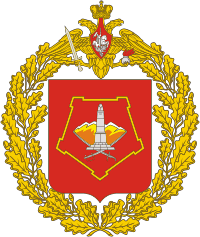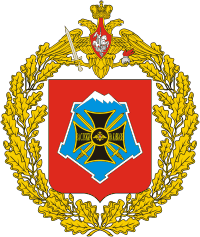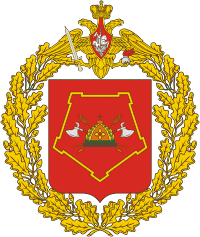
The 8th Guards Order of Lenin Combined Arms Army is an army of the Russian Ground Forces, headquartered in Novocherkassk, Rostov Oblast, within Russia′s Southern Military District, that was reinstated in 2017 as a successor to the 8th Guards Army of the Soviet Union's Red Army, which was formed during World War II and was disbanded in 1998 after being downsized into a corps. Military Unit в/ч 61877.
The 4th Army was a Soviet field army of World War II that served on the Eastern front of World War II and in the Caucasus during the Cold War. It was disbanded after the fall of the Soviet Union, with its divisions being withdrawn to Russia and disbanded.
A mechanised corps was a Soviet armoured formation used prior to the beginning of World War II and reintroduced during the war, in 1942.

The Volga–Ural Military District was a military district of the Russian Ground Forces, formed on 1 September 2001 by the amalgamation of the Volga Military District and the Ural Military District. The headquarters of the Ural Military District, located at Yekaterinburg became the new headquarters of the merged district. In 2010 the District was merged with part of the Siberian Military District to form the new Central Military District.

The North Caucasus Military District was a military district of the Russian Armed Forces from 1992-2010. Before 1992 it had been part of the Soviet Armed Forces since 1918. In 2010 it became the Southern Military District and lately also included the Black Sea Fleet and Caspian Flotilla.

The Siberian Military District was a Military district of the Russian Ground Forces. The district was originally formed as a military district of the Russian Empire in 1864. In 1924 it was reformed in the Red Army. After the end of World War II the district was split into the Western and Eastern Siberian Military Districts. In 1956 the district was reformed. In 2010 it was divided between the two newly formed Central and Eastern Military Districts.
The 5th Rifle Division was an infantry division of the Soviet Union's Red Army, formed twice. The division was formed in 1918, initially as the 2nd Penza Infantry Division. After becoming the 5th Rifle Division a month later, it fought in the Counteroffensive of Eastern Front in spring 1919 and later operations in Siberia. In the spring of 1920, the division was relocated west and fought in the Polish–Soviet War, participating in the Battle of Warsaw. The division was awarded the Honorary Revolutionary Red Banner for its actions during the wars in 1929. In September 1939, it fought in the Soviet invasion of Poland and was then sent to Lithuania under the Soviet–Lithuanian Mutual Assistance Treaty. After Operation Barbarossa, the division fought in the Baltic Operation and the Leningrad Strategic Defensive. During the winter of 1941-1942, it participated in the Battle of Moscow, fighting in the Kalinin (Tver) area. During the summer of 1942, the division fought in the Rzhev-Vyazma Offensive and became the 44th Guards Rifle Division for its actions there on 5 October.
A rifle corps was a Soviet corps-level military formation during the mid-twentieth century. Rifle corps were made up of a varying number of rifle divisions, although the allocation of three rifle divisions to a rifle corps was common during the latter part of World War II.

The Transbaikal Military District was a military district of first the Soviet Armed Forces and then the Armed Forces of the Russian Federation, formed on 17 May 1935 and included the Buryat Republic, Chita Oblast, and Yakutia. Chita was the headquarters of the district. It was finally disbanded on 1 December 1998 by being amalgamated with the Siberian Military District, though Chita remained the headquarters of the new amalgamated district.

The 51st Army was a field army of the Red Army that saw action against the Germans in World War II on both the southern and northern sectors of the front. The army participated in the Battle of the Kerch Peninsula between December 1941 and January 1942; it was destroyed in May 1942 with other Soviet forces when the Wehrmacht launched an operation to dislodge them from the peninsula. The army fought in the Battle of Stalingrad during the winter of 1942–43, helping to defeat German relief attempts. From late 1944 to the end of the war, the army fought in the final cutting-off of German forces in the Courland area next to the Baltic. Inactivated in 1945, the army was activated again in 1977 to secure Sakhalin and the Kuril Islands. Following the dissolution of the Soviet Union, the army continued in existence as a component of the Russian Ground Forces. The army was active during two periods from 1941 until 1997.

The 308th Rifle Division was a rifle division of the Soviet Red Army during World War II. The division was formed three separate times during the course of the war.
The 29th Rifle Division was an infantry division of the Red Army and later the Soviet Army.
The 62nd Rifle Division was an infantry division of the Soviet Union's Red Army, formed four times and active during World War II and the postwar period. The division was formed in 1936 and fought in the Winter War and Soviet occupation of Bessarabia and Northern Bukovina. It was destroyed during the Battle of Kiev in summer 1941. The division was reformed in November 1941. It fought in the defense against the German offensive Case Blue during the summer of 1942. After suffering heavy losses, it was withdrawn from combat but was sent back to fight in the Battle of Stalingrad in November. The division suffered heavy losses and was disbanded on 2 November. The division was reformed a third time from a rifle brigade in April 1943. It fought in Operation Suvorov, Operation Bagration, the East Prussian Offensive and the Prague Offensive. It was disbanded in the summer of 1945. The 62nd was reformed a fourth time by renaming the 360th Rifle Division, but became the 108th Motor Rifle Division in 1957.
The 81st Guards Rifle Division is an infantry division of the Russian Ground Forces, previously serving in the Red Army and the Soviet Army. It was formed after the Battle of Stalingrad from the 422nd Rifle Division in recognition of that division's actions during the battle, specifically the encirclement and the siege of the German forces in the city. The 81st Guards continued a record of distinguished service through the rest of the Great Patriotic War, and continued to serve postwar, as a rifle division and later a motor rifle division, until being reorganized as the 57th Separate Guards Motorized Rifle Brigade in 2009 in the Russian Ground Forces. Most of its postwar service was in the Soviet (Russian) far east, where it was originally formed as the 422nd.
The 315th Rifle Division was a standard Red Army rifle division formed for the first time on February 12, 1942, in the Siberian Military District before being sent to the vicinity of Stalingrad, where it was engaged in the futile efforts to break through to the besieged city from the north near Kotluban. After rebuilding, it was part of the southern thrust of Operation Uranus in November, helping to encircle the German 6th Army and also to hold off its would-be rescuers. During 1943 and early 1944 the division advanced through the southern Donbas and into Ukraine, where it was honored for its role in the liberation of Melitopol, before taking part in the liberation of the Crimea in April and May 1944. The men and women of the 315th ended their war on an anticlimactic note, serving for the last year as part of the garrison of the Crimea. However, the unit, and its successors, continued to serve well into the postwar era.
The 292nd Rifle Division was an infantry division of the Soviet Union's Red Army during World War II, formed three times.
The 341st Rifle Division was first formed in September 1941, as a standard Red Army rifle division, at Stalingrad. It was a "sister" unit to the 335th Rifle Division, which was formed at about the same time and place and shared a very similar combat path in its first formation. It was assigned to the southern sector of the Soviet-German front during the winter counteroffensive, but was effectively destroyed during the German spring offensive that formed the Izium Pocket, and was soon disbanded. The division was formed again almost exactly two years later, this time in the Karelian Front, facing Finland, and saw only limited action in the Continuation War before being assigned to coastal defense duties during 1945. The 341st Rifle Division continued to serve well into the Cold War, eventually being re-designated and becoming a motorized rifle division.
The 56th Rifle Division was an infantry division of the Red Army and later the Soviet Army of the Soviet Union, formed three times.






